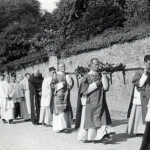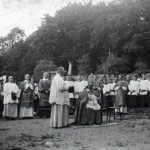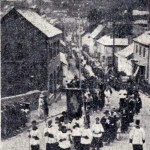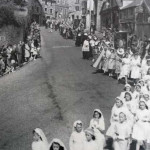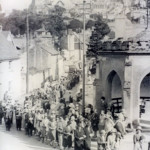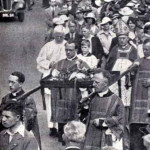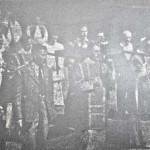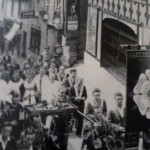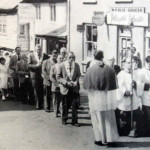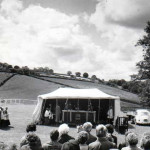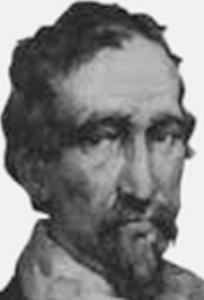
Cuthbert Mayne was born at Youlston, near Barnstaple in Devon, the son of William Mayne, and baptised on 20 March 1543/4, St Cuthbert’s day. This uncle paid his way to Barnstaple Grammar School, and he was ordained a Protestant minister at the age of eighteen or nineteen and instituted rector of Huntshaw, near his birthplace. After ordination, Mayne attended university, first at St Alban Hall, then at St John’s College, in Oxford, where he was made chaplain. He became B.A. on 6 April 1566 and M.A. on 8 April 1570.
At Oxford, Mayne met Edmund Campion and other Catholics, such as Gregory Martin, Humphrey Ely, Henry Shaw, Thomas Bramston, Henry Holland, Jonas Meredith, Roland Russell, and William Wiggs. At some point Mayne, too, became a Catholic. Late in 1570, a letter addressed to him from Gregory Martin fell into the hands of the Bishop of London, and officers arrested him and the others mentioned in the letter. Being warned off by Thomas Ford, Mayne evaded arrest by going to Cornwall and then, in 1573, to the English College at Douai.
Mayne was ordained a priest at Douai in 1575 and on 7 February in the following year he obtained the degree of Bachelor of Theology of Douai University. Shortly afterwards, on 24 April 1576, he left for the English mission in the company of another priest, John Payne. He soon took up his abode with Francis Tregian, in the parish of Probus, Cornwall.
The few missionaries who arrived from Douai, once their existence was learned by agents of Elizabeth I’s government, were then looked upon as a large force of papal agents meant to overthrow the Queen.The authorities began a systematic search in June 1576, when the Bishop of Exeter William Broadbridge came to the area in Cornwall. High sheriff Sir Richard Grenville, a noted anti-Catholic officer, conducted a raid on Tregian’s house on 8 June 1577, during which the crown officers “bounced and beat at the door” to Mayne’s chamber. On gaining entry, Grenville discovered a Catholic devotional article, an Agnus Dei around Mayne’s neck, and took him into custody along with his books and papers. Tregian suffered imprisonment and loss of possessions for harbouring a Roman Catholic priest.
While awaiting trial at the circuit assizes in September, Mayne was imprisoned in Launceston gaol, being chained to his bedposts. The authorities sought a death sentence but had difficulty in framing a treason indictment to that end. At the opening of the trial on 23 September 1577 there were five counts against him: first, that he had obtained from the Roman See a “faculty” (or bulla), containing absolution of the Queen’s subjects ; second, that he had published the same at Golden; third, that he had taught the ecclesiastical authority of the Pope and denied the queen’s ecclesiastical supremacy while in prison; fourth, that he had brought into the kingdom an Agnus Dei and delivered it to Francis Tregian; fifth, that he had celebrated Mass.
Mayne answered all counts. On the first and second counts, he said that the supposed “faculty” was merely a copy printed at Douai of an announcement of the Jubilee of 1575, and that its application having expired with the end of the jubilee, he certainly had not published it either at Golden (the manor house of Francis Tregian) or elsewhere. On the third count, he said that he had asserted nothing definite on the subject to the three illiterate witnesses who swore to the contrary. On the fourth count, he said that the fact he was wearing an Agnus Dei at the time of his arrest did not establish that he had brought it into the kingdom or delivered it to Tregian. On the fifth count, he said that the presence of a Missal, a chalice, and vestments in his room did not establish that he had said Mass.
The trial judge, Justice Sir Roger Manwood, directed the jury to return a verdict of guilty, stating that, “where plain proofs were wanting, strong presumptions ought to take place”. Manwood also argued that it was illegal to introduce any papal letter into the country, no matter what it was. The circumstantial case, in other words, was to be sufficient to prove the indictments. The jury found Mayne guilty of high treason on all counts, and accordingly he was sentenced to be hanged, drawn and quartered. Mayne responded, “Deo gratias”.
With him had been arraigned Francis Tregian and eight other laymen. The eight were sentenced to seizure of their goods and life imprisonment, Tregian to die (in fact he spent 26 years in prison).
After the sentencing, Judge Jeffries took exception to the proceedings and referred the matter to the Privy Council. The Council submitted the case to the whole bench of judges, which was inclined to leniency on the grounds of the flimsiness of the evidence. Nevertheless, the council ordered the execution to proceed.
At the examination of Mayne after the trial, Mayne admitted to having said mass. The Record Office also recorded that among his papers were notes which brought him under suspicion of the charge that Catholics were bound, in the right opportunity, to rise against the Queen. The same office also recorded him admitting to this during his examination after the trial:
‘The words found in a book of his signifying that though the catholic religion did now serve, swear and obey, yet if occasion were offered they would be ready to help the execution, &c., were annexed to a text taken out of a general council of Lateran for the authority of the pope in his excommunication, and at the last council of Trent there was a consent of the catholic princes for a reformation of such realms and persons as had gone from the authority of the bishop of Rome, when it was concluded that if any catholic prince took in hand to invade any realm to reform the same to the authority of the see of Rome, that then the catholics in that realm should be ready to assist and help them. And this was the meaning of the execution as he saith, whiph he never revealed to any man before.’ (Mayne had also supposedly stated that) ‘ the people of England may be won unto the catholic religion of the see of Rome by such secret instructions as either are or may be within the realm; but what these secret instructions are he will not utter, but hopeth when time serveth they shall do therein as pleaseth God.’
Before being brought to the place of execution, Cuthbert Mayne was offered his life in return for a renunciation of his religion and an acknowledgment of the supremacy of the queen as head of the church. Declining both offers, he kissed a copy of the Bible, declaring that, “the queen neither ever was, nor is, nor ever shall be, the head of the church of England”.
On his execution day, Cuthbert was dragged on a hurdle to the square to be hanged for his beliefs. The under-sheriff of Cornwall, George Grenville, would not allow the priest’s head to be banged on the stones as he was bumped along the rough road as was general with prisoners about to be hanged. Once Mayne was hoisted up the justices wanted him cut down so that he could be drawn and quartered whilst still alive but Grenville again showed pity and allowed him to die on the gibbet before these operations were carried out, on November 30th, 1577, in the town square.
Relics of Mayne’s body survive in various locations. He was the first “seminary priest”, the group of priests who were trained not in England but in houses of studies on the Continent. He was also one of the group of prominent Catholic martyrs of the persecution who were later designated as the Forty Martyrs of England and Wales.
There are many memorials to him in Launceston, and the Catholic Church is named after him.
Mayne was beatified “equipollently” by Pope Leo XIII, by means of a decree of 29 December 1886 and was canonized along with the other Martyrs of England and Wales by Pope Paul VI on 25 October 1970.
From 1921 the Catholic Church began holding ceremonies in Cuthbert Mayne’s name carrying his relic in procession through the town to the Castle. In the past the processions head would be at the Castle Green before the last ones had left the field by the Catholic Church. It was one continuous stream of people taking up the whole width of the road with a total attendance of 7,000 people. The field they used to start from and finish is where the Cuthbert & Mayne Close’s are now situated just above the Cuthbert Mayne Catholic Church. Nowadays the ceremonies are only held every few years.
Visits: 137

